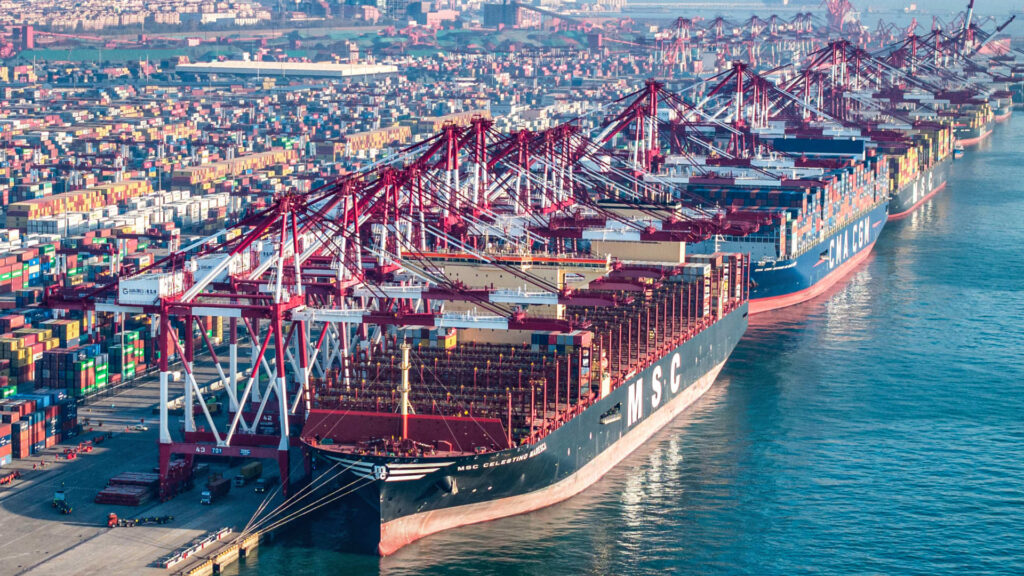Cargo ships and containers at Qingdao port in eastern China’s Shandong province on Dec. 4, 2024.
Stringer | Afp | Getty Images
The World Trade Organization warned on Wednesday that the outlook for global trade has “deteriorated sharply” in the wake of U.S. President Donald Trump’s tariffs regime.
“The outlook for global trade has deteriorated sharply due to a surge in tariffs and trade policy uncertainty,” the WTO said in its latest “Global Trade Outlook and Statistics” report out Wednesday.
Based on the tariffs currently in place, and including a 90-day suspension of “reciprocal tariffs,” the volume of world merchandise trade is now expected to decline by 0.2% in 2025, before posting a “modest” recovery of 2.5% in 2026.
The decline is anticipated to be particularly steep in North America, where exports are forecast to drop by 12.6% this year.
The WTO also warned that “severe downside risks exist,” including the application of “reciprocal” tariffs and a broader spillover of policy uncertainty, “which could lead to an even sharper decline of 1.5% in global goods trade,” particularly hurting export-oriented, least-developed countries.
The recent tariff disturbances follow a strong year for world trade in 2024, during which merchandise trade grew 2.9% and commercial services trade expanded by 6.8%, the WTO said.
The new estimate of a 0.2% decline in world trade for 2025 is nearly 3 percentage points lower than it would have been under a “low tariff” baseline scenario, the WTO added, and marks a significant reversal from the start of the year when the trade body’s economists expected to see continued trade expansion supported by improving macroeconomic conditions.
“Risks to the forecast include the implementation of the currently suspended reciprocal tariffs by the United States, as well as a broader spillover of trade policy uncertainty beyond U.S.-linked trade relationships,” the WTO said.
“If enacted, reciprocal tariffs would reduce world merchandise trade growth by an additional 0.6 percentage points, posing particular risks for least-developed countries (LDCs), while a spreading of trade policy uncertainty (TPU) would shave off a further 0.8 percentage points. Taken together, the reciprocal tariffs and spreading TPU would lead to a 1.5% decline in world merchandise trade volume in 2025.”
U.S. President Donald Trump delivers remarks on tariffs in the Rose Garden at the White House in Washington, D.C., on April 2, 2025.
Carlos Barria | Reuters
Trump stunned trading partners and global markets in early April, when he announced a raft of so-called reciprocal tariffs on imports from more than 180 countries. Beijing was hit the hardest of all, with the U.S. duty on Chinese imports now effectively totaling 145%. China in turn struck back at Washington with retaliatory tariffs of up to 125% on U.S. imports.
The tariffs between China and the U.S. will likely to lead to a “drastic contraction” of trade between the two, Ralph Ossa, chief economist at the WTO, told CNBC’s Silvia Amaro on Wednesday.
Widespread market turbulence following the tariffs announcement prompted a temporary climbdown by Trump, with the president last week announcing that the new duties on imports from most trading partners would be reduced to 10% for 90 days in order to allow for trade negotiations with Washington’s counterparts.
The WTO said in its Wednesday report that the impact of recent trade policy changes is likely to vary sharply from region to region.
In the adjusted forecast, North America now subtracts 1.7 percentage points from global merchandise trade growth in 2025, turning the overall figure negative.
Meanwhile, Asia and Europe continue to contribute positively, but less than in the baseline scenario, with Asia’s input halved to 0.6 percentage point.
The disruption in U.S.-China trade is expected “to trigger significant trade diversion,” the WTO added, raising concerns among third markets about increased competition from China.
“Chinese merchandise exports are projected to rise by 4% to 9% across all regions outside North America as trade is redirected. At the same time, U.S. imports from China are expected to fall sharply in sectors such as textiles, apparel and electrical equipment, creating new export opportunities for other suppliers able to fill the gap,” the trade organization remarked, noting that this could open the door for some least-developed countries to increase their exports to the U.S. market.
Many WTO members have raised the issue of trade diversion, Ossa said.
“But one thing that’s really important to keep in mind is that this is a two-way street in a way, if you think about European firms for example trying to export cars to the United States, they also face a 25% tariff now and they will also need to find new destination markets for these products. So, its not just Chinese goods coming into Europe for example but its also European goods that need new customers,” he said.
Ossa added that it was important for these effects to be managed in a cooperative way.
— CNBC’s Sophie Kiderlin contributed to this report.

